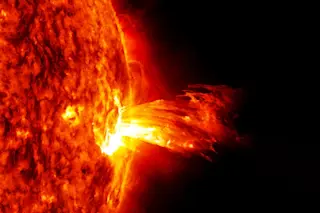Cosmic rays--subatomic particles that zip across space at nearly the speed of light--rain down on Earth’s atmosphere all the time. The sun produces some of these particles, but most come from beyond the solar system. No one knows exactly from where, though, because magnetic fields in space warp the paths of the charged particles, making it hard to trace them to any particular source. But after decades of searching, astronomers have finally found solid evidence that exploding stars, or supernovas, are at least one source of cosmic rays.
Supernovas have actually been prime suspects all along. The shock waves created by a supernova explosion, astronomers theorized, could generate enormous magnetic fields capable of accelerating electrons, protons, and other ions to nearly the speed of light. But detecting this acceleration has proved very difficult. The accelerated particles should emit X-rays--but Earth’s atmosphere blocks those, making satellite observations necessary. Moreover, the radiation from the particles also has to compete with X-rays coming from the slowly cooling supernova itself.
In 1993 the Japanese-American satellite called ASCA trained its instruments on a supernova remnant in the southern constellation Lupus, some 2,000 light-years distant. The light from this star’s explosion reached Earth in 1006 and was so intense it rivaled the moon in brightness. The expanding cloud of superhot gas left by the explosion is now barely detectable at visible wavelengths, but it is an extremely strong source of X-rays.
When astrophysicist Robert Petre of NASA’s Goddard Space Flight Center and his colleagues analyzed the ASCA data, they found that most of the Lupus supernova remnant had spikes in its X-ray spectrum--the radiation peaked at a few wavelengths. This was a sign that the X-rays came from electrons still bound to atoms in the gas; as bound electrons fall from one atomic orbit to another, they emit radiation at a specific wavelength. But along the outer edge of the expanding cloud, where the shock wave from the explosion is still plowing into the interstellar medium, the spectrum changed from spiky to smooth, with X-rays of all wavelengths being emitted. Only accelerated, unbound electrons produce such a continuous range of X- rays, says Petre. And such electrons are one of the main types of cosmic ray.
Petre cautions, though, that astronomers are far from settling the cosmic-ray mystery. Supernovas may not be the major source of these particles; black holes and neutron stars may also be capable of accelerating particles to cosmic-ray energies. We’ve identified one high- energy cosmic-ray source within the Milky Way, he says, but whether this is the archetype or just an oddball is hard to say.














